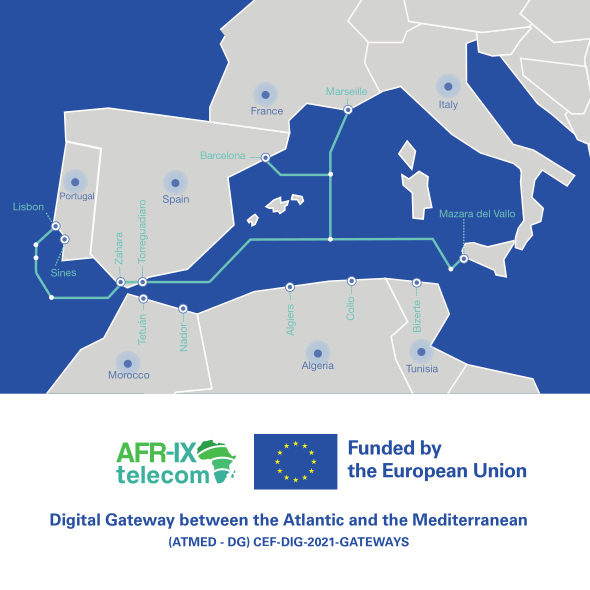EU Commission grants AFR-IX telecom’s ATMED-DG project to finance the deployment of a fibre pair between Lisbon and Mazara del Vallo

Medusa, a submarine fiber optic cable system, will span a total length of 8,700 km. This strategic project aims to enhance connectivity among European Union countries. Consequently, the EU Commission awarded AFR-IX telecom €7.79 million for the ATMED-DG (Atlantic-Mediterranean Data Gateway) project. This funding will support the deployment of a dark fiber pair connecting Lisbon, Zahara de los Atunes, Barcelona, Marseille, and Mazara del Vallo. Notably, the ATMED-DG project covers the Western Mediterranean cable section, which is 3,889 km long. The first cable to link landing stations in Portugal, Spain, France, and Italy through a single submarine cable infrastructure.
The project, that started on 1st of March 2023, has been granted under the call Backbone connectivity for Digital Global Gateways (CEF-DIG-2021-GATEWAYS).
The ATMED-DG project is part of the CEF (Connecting Europe Facility) programme. Supporting the implementation of strategic networks to improve the connectivity of EU countries. In this sense, it should be noted that the current state of the submarine connections in the Mediterranean region presents some conditions and deficiencies that ATMED-DG will be able to solve.
AFR-IX telecom’s ATMED-DG project is offering significant increase in connectivity between different countries involved. Playing an important role in the creation of a Mediterranean Data Gateway
ATMED-DG, digital gateway between the Mediterranean and the Atlantic
The ATMED-DG project features a submarine optic-fiber pair connecting Lisbon (Portugal) to Mazara del Vallo (Italy). This will create the largest and fastest submarine optical fiber line in the Mediterranean Sea, laying the foundation for the Mediterranean Data Gateway. Along this main cable, multiple branching units (BUs) will link European landing sites to the main trunk. These sites include Zahara de los Atunes, Torreguadiaro, and Barcelona in Spain, as well as Marseille in France.
Unlike existing cables, which primarily connect the Mediterranean to other continents and serve a few European ports. ATMED-DG will connect multiple Mediterranean European data ports. This will address the current infrastructure’s limitations, which struggle to meet the increasing demand for connectivity. Furthermore, ATMED-DG will offer an open access cable for third parties. Enabling 10X-20X more capacity, Point of Presence (PoP) connectivity, and significantly lower maintenance costs.

This project has received funding from the European Union’s under grant agreement No 101094487




